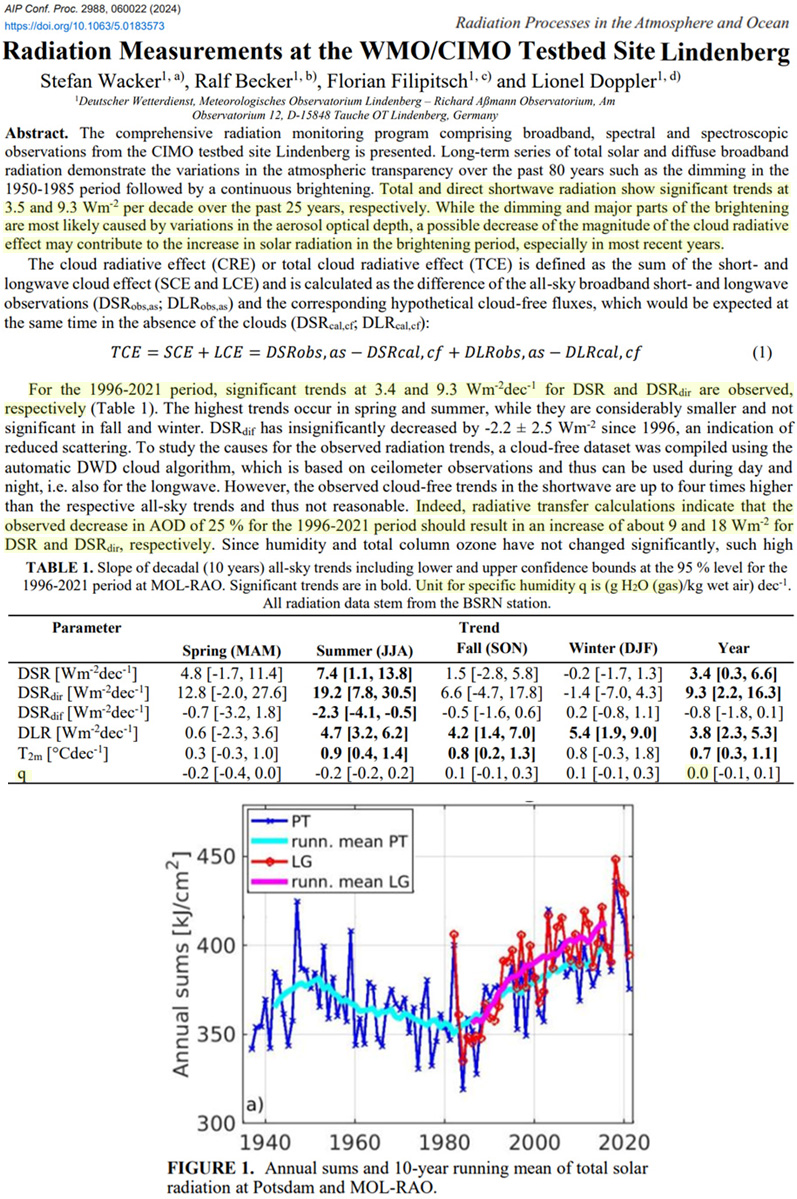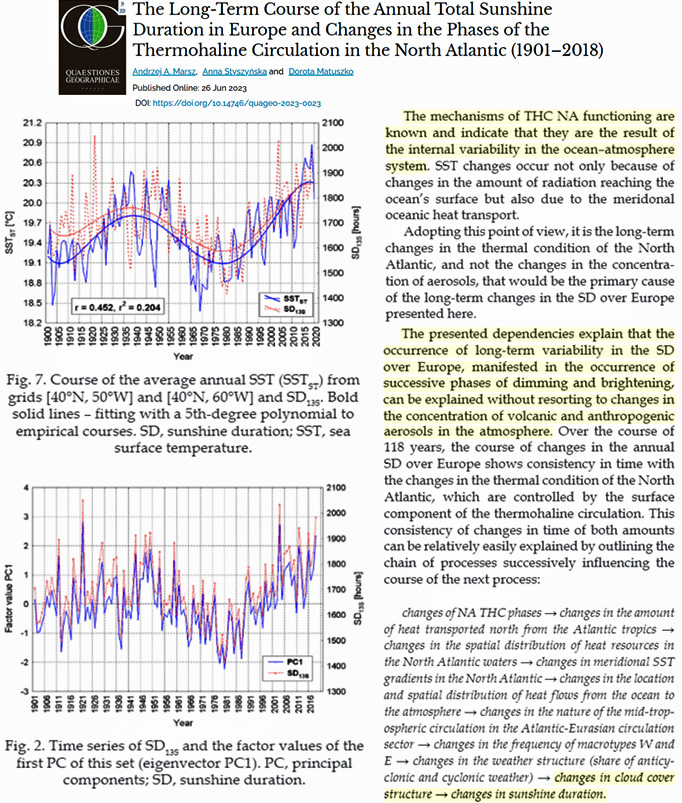Across Europe there has been a downward trend in cloud and aerosol albedo over the last 40 years, allowing more solar radiation to reach the surface. This “brightening” effect thus explains recent warming.
A new study (Wacker et al., 2024) from a “testbed site” in Germany reports total and direct shortwave (SW) radiation forcing rose by 3.5 and 9.3 W/m² per decade, respectively, from 1996-2021 over Germany.
Compare these much larger per-decade forcing trends to the much tinier (0.2 W/m² per decade) climate impact that CO2 allegedly has in clear-sky.

Image Source: Wacker et al., 2024
Another new study, Natsis et al., 2024, finds Greece has also sustained a significant increasing trend in “downward shortwave solar irradiance” since 1993.
“Monitoring the trends of the downward shortwave solar irradiance or Global Horizontal Irradiance (GHI), is an important tool, for evaluating long term changes of the local climate and in revealing some local atmospheric characteristics. Here, we analyse data from a pyranometer installed at the Laboratory of Atmospheric Physics in Thessaloniki. The location of the monitoring site is within the urban area and near the commercial centre of the city, thus we expect that the atmospheric attenuation of radiation is strongly affected by the human activities in the area. Observed GHI trends in different locations worldwide revealed either negative or positive tendencies if GHI, mainly due to combined effects of local factors. On global scale, studies have reported a decrease in GHI for the period 1960–1980, known as ‘global dimming’, followed by a decrease since the late 1980s, known as ‘global brightening’ (Wild, 2009, 2012).”
“In this study, we are reporting increasing trends in downward shortwave solar irradiance from measurements at Thessaloniki, Greece for the period 1993-2021. The main drive of this study was to investigate whether the longterm increases in GHI that have been reported in an earlier study (Bais et al., 2013) continue also in the 10-year longer dataset. We confirmed the continuation and a slight enhancement of the linear trend (0.43% per year for allskies and 0.24% per year for clear skies). The two main factors that may have caused the observed solar radiation brightening over Thessaloniki are the reduction of the aerosol optical depth, and changes in cloud cover and optical depth. Another factor, could be a possible increase in the enhancement cases of the GHI by the clouds (Vamvakas et al., 2020), which will be investigated in a subsequent study together with the role of clouds. Our findings are in accordance with other studies (Wild 2012, 2009; Philipona et al., 2009; Kazadzis et al. 2007), that have also reported increases in GHI in other locations.”
Europe as a whole has “experienced an increase in surface solar radiation, termed ‘brightening’, since the 1980s” (Schilliger et al., 2024) due to trends in cloud and aerosol shortwave forcing.
“Surface solar radiation is fundamental for terrestrial life. It provides warmth to make our planet habitable, drives atmospheric circulation, the hydrological cycle and photosynthesis. Europe has experienced an increase in surface solar radiation, termed ‘brightening’, since the 1980s. This study investigates the causative factors behind this brightening. A novel algorithm from the EUMETSAT satellite application facility on climate monitoring (CM SAF) provides the unique opportunity to simulate surface solar radiation under various atmospheric conditions for clouds (clear-sky or all-sky), aerosol optical depth (time-varying or climatological averages) and water vapor content (with or without its direct influence on surface solar radiation). Through a multiple linear regression approach, the study attributes brightening trends to changes in these atmospheric parameters. Analyzing 61 locations distributed across Europe from 1983 to 2020, aerosols emerge as key driver during 1983-2002, with Southern Europe and high elevations showing subdued effects (0-1%/decade) versus more pronounced impacts in Northern and Eastern Europe (2-6%/decade). Cloud effects exhibit spatial variability, inducing a negative effect on surface solar radiation (-3 to -2%/decade) at most investigated locations in the same period. In the subsequent period 2001-2020, aerosol effects are negligible, while cloud effects dominate the observed brightening (2-5%/decade). This study therefore finds a substantial decrease in the cloud radiative forcing over Europe in the first two decades of the 21st century. Water vapor exerts negligible influence in both sub-periods.”
A year ago Marsz et al. (2023) presented compelling evidence that decadal-scale sunshine duration variations across Europe and the North Atlantic are driven by the internal (non-anthropogenic) processes affecting cloud cover, namely the natural thermohaline circulation in the North Atlantic (THC NA). This relationship spans the entire period from 1900 to 2018.
“The mechanisms of the THC NA functioning are known and indicate that they are the result of the internal variability in the ocean-atmosphere system.”
“SST changes occur not only because of changes in the amount of radiation reaching the ocean’s surface but also due to the meridonal oceanic heat transport.”
“[I]t is the long-term changes in the thermal condition of the North Atlantic, and not changes in the concentration of aerosols, that would be the primary cause of the long-term change in the SD over Europe.”
“[T]he occurrence of long-term variability in the SD over Europe, manifested in the occurrence of successive phases of dimming and brightening, can be explained without resorting to changes in the concentration of volcanic and anthropogenic aerosols in the atmosphere.”






[…] From NoTricksZone […]
very nice content